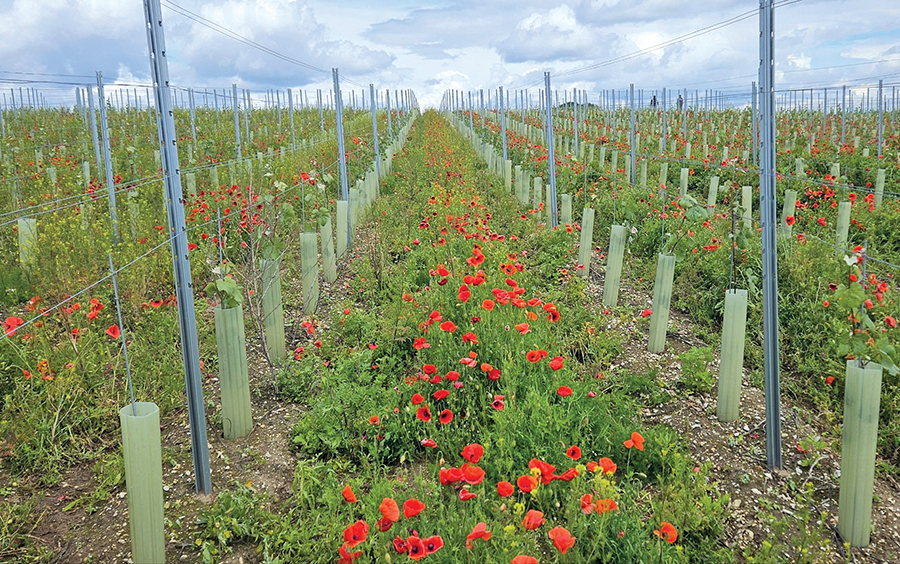Cover cropping in UK vineyards
1st September 2024
VineWorks business director, Chris Buckley, discusses the importance of soil health and the benefits cover crops can bring to the vineyard.

As autumn approaches, harvest may or may not be complete and your vines will soon go into dormancy. It will soon be time to reflect and put plans in place on enhancing the upcoming season. Vineyard management is a complex task, with no single formula for success.
Each vineyard is unique, necessitating tailored strategies to maximise vine productivity. While climate plays a crucial role, soil health is arguably the most significant factor in your vineyard’s success.
The role of soil management
In recent decades, soil management has primarily focused on physical and chemical aspects. However, the biological component, known as the ‘soil food web’, is equally vital. This web comprises everything from mammals to bacteria, each playing a crucial role.
A few grammes of soil can contain upwards of billions of microorganisms. Around roots though, there can be approximately 2,000 to 5,000 times more microorganisms than in the surrounding soil! Living roots in the soil are crucial.
This dense microbial activity is essential for nutrient cycling, soil structure, and overall plant health. In addition to supporting biology in the soil, living roots can – depending on the plants – reduce soil erosion, improve soil structure and water infiltration, reduce compaction, scavenge or fix nitrogen, increase organic matter, suppress weeds, and build soil fertility.
Why plant cover crops
Living roots in the soil means using a cover crop or permanent grass cover in the vineyard alleyways. Permanent grass cover tends to represent less biodiversity, but is often the easiest option to manage.
Using cover crop mixes, and in some cases rotating them, can offer greater biodiversity and a range of additional benefits beyond that offered by grass. There is no one-size-fits-all approach. Experimenting with different cover crops is important to find the best fit for your specific site, soil conditions, and vine requirements, and these will change year to year. Different species of cover crops – within the families of brassicas, legumes and grasses – can offer varying benefits, so it is a case of ongoing experimentation to assess what works best and when in your vineyard.
Soil organisms, including fungi and bacteria, decompose plant tissue into nutritious food for your vines. A natural and diverse diet leads to healthier plants with stronger immune systems, compared to those reliant on chemical supplements.
Bare soil eventually depletes organic matter, leading to the decline of beneficial fungi and the rise of anaerobic bacteria. Grapevines thrive in soils with a high fungal presence, a balanced carbon:nitrogen ratio, and good aeration. Cover crops contribute carbon and organic matter, with deep-rooting varieties facilitating water infiltration and air space, reducing evaporation, and lowering disease risk.
In summary, the benefits of cover crops include:
- Hosts beneficial insects
- Provides organic matter
- Prevents erosion
- Improves soil structure
- Enhances drainage
- Aids water retention
- Increases nutrient cycling
- Improves soil aeration
- Promotes mycorrhizal fungi
- Boosts biological activity.
- When to plant cover crops
The UK’s natural ripening season is relatively short, so maximising your terroir’s potential is essential. A healthy, diverse cover crop unlocks a broader range of nutrients for your plants. Robust ground cover also allows access with heavy machinery in challenging conditions.
Depending on your goals and chosen varieties, sow your cover crop in either spring or autumn into well-prepared soil using a combo power harrow-seed drill. Since this is an infrequent operation, hiring a seed drill from local contractors may be more cost-effective. Consult with your agronomist and local seed supplier to select the right mix for your needs, and let nature do the groundwork.
About our author
VineWorks has been establishing and supporting UK vineyards since 2006. With over 4.5 million vines planted, 300 vineyards established and thousands of tonnes of grapes hand-harvested, our expertise comes from experience.
Read more vine news
